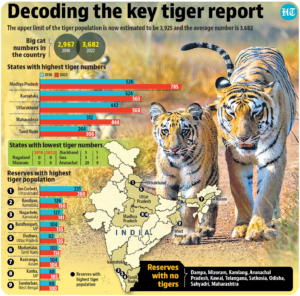ForumIAS announcing GS Foundation Program for UPSC CSE 2025-26 from 19 April. Click Here for more information.
ForumIAS Answer Writing Focus Group (AWFG) for Mains 2024 commencing from 24th June 2024. The Entrance Test for the program will be held on 28th April 2024 at 9 AM. To know more about the program visit: https://forumias.com/blog/awfg2024
Source: The post is based on the article “All India Tiger Estimation -2022: Release of the detailed Report” published in PIB on 31st July 2023.
What is the News?
On the occasion of the Global Tiger Day celebrated at the Corbett Tiger Reserve on 29th July 2023, Government of India has released the “Status of Tigers Report 2022”.
What are the key highlights from the report?
Source: Hindustan Times
Tiger Population in India: The number of tigers in India has increased from 2,967 in 2018 to 3,682 in 2022, an annual rise of 6%.The upper limit of the tiger population is estimated to be 3925 and the average number is 3682 tigers.
– With this, India currently harbors almost 75% of the world’s wild tiger population.
Tiger Reserves: India has 53 Tiger Reserves spread across 75,796 km2, effectively covering 2.3% of India’s total land area.
Region wise: Central India and the Shivalik Hills and Gangetic Plains witnessed a notable increase in tiger population.
– However, certain regions such as the Western Ghats experienced localized declines, necessitating targeted monitoring and conservation efforts.
Tigers state wise: The largest tiger population of 785 is in Madhya Pradesh, followed by Karnataka (563) & Uttarakhand (560), and Maharashtra (444).
– However, some states such as Mizoram, Nagaland, Jharkhand, Goa, Chhattisgarh, and Arunachal Pradesh, have reported small tiger populations.
Tiger reserves population wise: The tiger abundance within the Tiger Reserve is highest in Corbett (260), followed by Bandipur (150), Nagarhole (141) and Bandhavgarh (135).
Suggestions: Approximately 35% of the tiger reserves urgently require enhanced protection measures, habitat restoration, ungulate augmentation, and subsequent tiger reintroduction.
– To preserve ecological integrity, we must prioritize eco-friendly development, minimize mining impacts, and rehabilitate mining sites.
– Further, to protect tiger population we must: fortify protected area management, intensify anti-poaching measures, employ scientific thinking and technology for data collection and address human-wildlife conflict.





